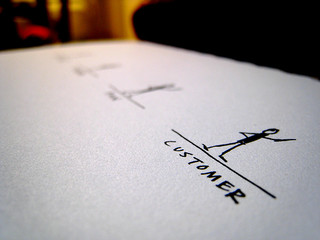
Updated May 2021: Estimated reading time: 3 minutes
There are several different ways to calculate customer value when measuring your event ROI. Customer value as a dollar figure identifies how much revenue an event generates. When divided by costs, the result is a simple Return-on-Investment (ROI) calculation.
Annualized Sales per Household
One simple method of calculating customer value through event ROI starts by identifying the number of purchases made per household for the product category over a 12 month period:
- Juice might be once a week
- A car might be every five years
- Cough medicine might be twice a year
- Insurance might be monthly
Once you’ve identified the number of purchases per year you, multiply that by the cost per purchase. For example, laundry detergent purchased six times per year at $12.95 per purchase would yield $77.70 in annual revenue per customer. The “per purchase” amount is simply an average price per SKU across multiple retail locations.
I’ve seen it done where a profit figure is used (average revenue per SKU minus costs of goods sold), but 99% of the time we find the project team would prefer to just use a revenue figure.
Lifetime Customer Value
In many cases, it makes sense to look at customer value beyond the first 12 months of purchase behavior. We have one client that looks at customer valuation over a 10-year life cycle. Others think about it in the context of two or three years out. Lifetime customer value is simply calculated by multiplying the annualized value by the number of years you want to project.
The laundry detergent example would produce a “lifetime” customer value of $233.10 over a three-year period. If your client team is finance-focused, you might want to treat year two and three revenue as an annuity here and subtract out the cost of capital to keep it conservative. On the other hand, if they don’t bring it up, I wouldn’t either.
The period of loyalty varies by brand and brand category. In CPG, customers jump around based on the category. They may be loyal to a brand for a few years, then start to experiment with others further down the road. Most brands see their percentage of loyal customers decline year over year.
Conclusion
These are places to start. We’ve seen some highly sophisticated models of customer value used. They’re great fun to work with, but most of the time, the simple methods outlined above work just fine.
To sum up, modeling the ROI of events isn’t about reporting to investment bankers about the company’s financial future. It’s about finding a way to standardize the evaluation of your event marketing in a way that provides valid information on how events contribute to the overall marketing mix.
Don’t over-complicate things. Start simple. Let it build from there.

Additional Resources
FOR EXPERIENTIAL MARKETERS
- Experiential Measurement Blueprint
- Event Impression Calculator
- Experiential ROI Benchmarking Reports
- Event Measurement Video Tutorials
Photo Source: https://www.flickr.com/photos/10ch/
